To See Myself Reflected: An Interview With Jillian Tamaki
by Annie Mok

Jillian Tamaki is my hero. She moves like a shark; like a very funny comics-drawing shark. Last year, First Second released the Caldecott Award-winning This One Summer, a young adult graphic novel Jillian created with her cousin, Mariko Tamaki. This One Summer was her second collaboration with Mariko — the first, Skim, was a goth Lolita teen drama published in 2008.
Jillian illustrates for The New York Times, among others, and she created two books of stand-alone drawings and comics: Gilded Lilies (2006) and Indoor Voice (2010).
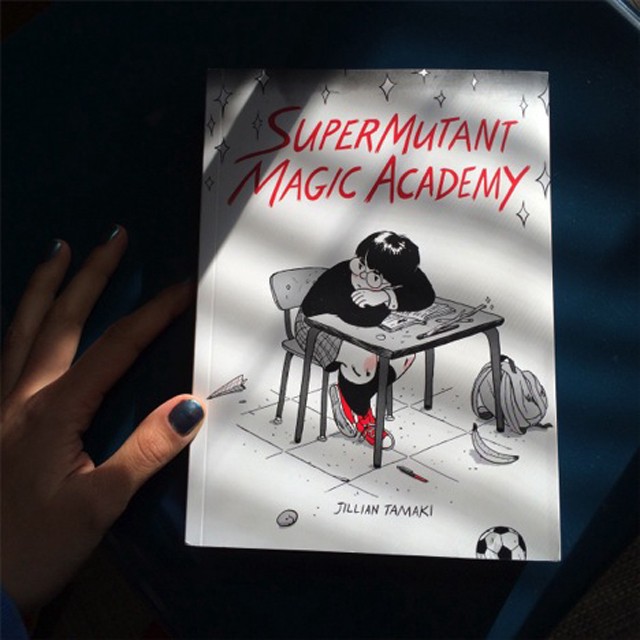
On April 28, Drawn & Quarterly released the long-awaited collection of her webcomic, SuperMutant Magic Academy. SMMA shows what Hogwarts — or maybe Professor X’s School in X-Men — would be like if the adolescent student body talked about the empirical perfection of each others’ butts, did oblique performance art with piles of cotton balls, and creeped each other out with painfully bad flirting.
This month Jillian will also release the haunting SexCoven, a comic about memes, youth, and relationships, for Youth in Decline’s Frontier #7. Jillian and I spoke over email about the difference between art versus Art, fantastical characters dealing with the utter mundane, and the benefit of rapid-fire, low-stakes, messy, rambling work.
How did the process of making these loosely-drawn, one-and-done style strips feel in comparison to tightly polished work, like your drawings in This One Summer?
Well, the process behind a project like this is really different from a graphic novel. The graphic novels I have worked on (Skim, This One Summer) were very concerted, intense efforts. Sketches to pencils to inks to digital, then repeat ad nauseam.
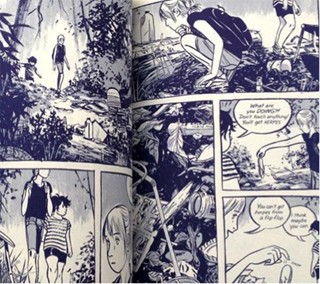
That creates a very specific effect. It fits those stories, which are relatively conventional. The point of starting a webcomic was to explore different possibilities for comic-making and to work on the “writing” aspect of comics.
I always learn a lot from the bigger, polished projects (and from working with Mariko), but I wanted something very rapid-fire, low-stakes, messy, rambling. The SMMA strips vary stylistically, depending on my mood when I made them or how much time I had or even the time of day I made them — I did a lot of them very late at night.
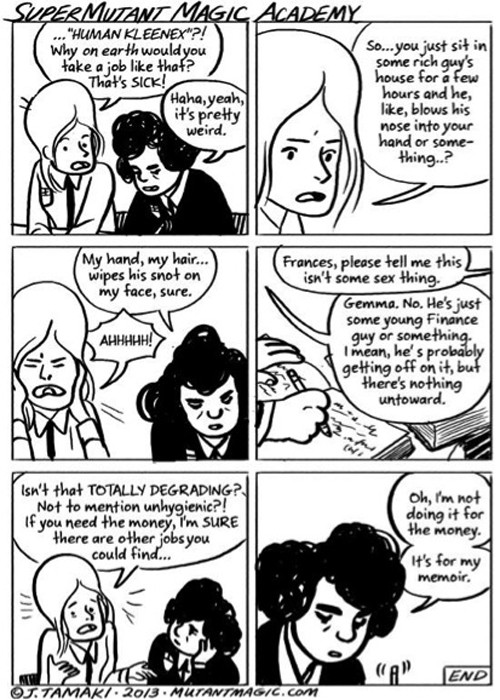
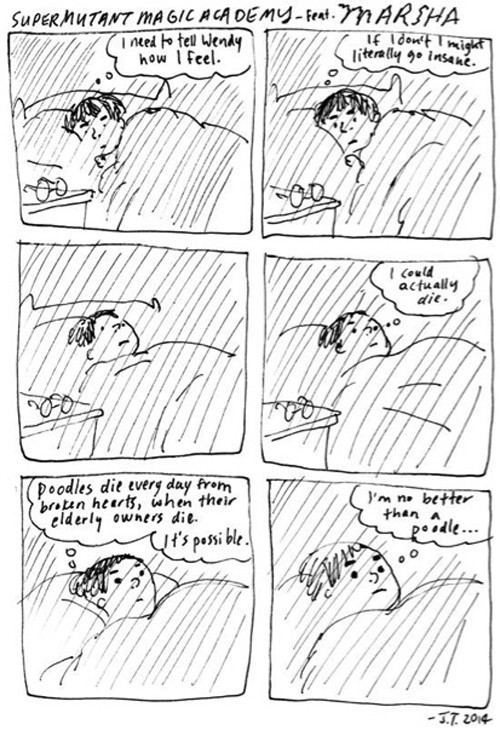
Like a lot of readers, I quickly latched onto the characters Frances and Marsha. Frances is a fiery performance artist who, in one strip, throws blood onto boys, and is only shocked when her teacher says, “Guerrilla performance art? A little… seventies, no?” Marsha is a closeted, bitter, sex-obsessed dork who suffers under the weight of a secret crush on her straight best friend, Wendy, a shape-shifting human/fox. Can you talk about the process of developing these characters and their world? The universe of SMMA seems to have grown organically, strip by strip.
I feel like characters cropped up whenever I needed them. Marsha, for example, was sort of just an add-on friend to Wendy, who was conceived of first (because every “high school world” needs a cute girl everyone has a crush on, I guess). There was no forethought to any arc, characters, or anything, which is an element of the project that people might find interesting or a weakness. You really see the whole thing spring from an intentionally stupid conceit.
There is no world that surrounds SuperMutant Magic Academy, really. That’s not intentional or unintentional. I’m not interested in castles or wizarding class or fantastical monsters…only, like, disappointing food, or being ignored by your friend, or trying to make sense of your own body. I liked the absurdity of this fantastical cast dealing with the utter mundane.
Every book I work on is a portrait of a specific time in my life. Almost like a set of bookends. So some of the characters are directly inspired by people that were in my life at the time. It’s funny how often you forget what exactly inspired the strips in the first place (a lot of the time I would bust out a strip in response to something that I was thinking/had observed/overheard/etc), so you’re just left with an emotional impression.
SMMA as a school environment seems egalitarian; the nerdier kids can be bullying, the jocks bright and tender. I also love the portrayal of teachers: several strips explore the “awkward adult trying to get kids excited” trope to lovely effect (one teacher says, with a big smile, “What I’m saying is books are amazing, guys”). Many storylines center around artmaking and how art critiques poke the buttons of both artist and viewer. You taught for some years at the School of Visual Arts in Manhattan; can you tell me about how your observations as a teacher, and/or as a student when you were younger, may have informed SMMA?
I think it’s a combination of being both a teacher and student. I was always interested in art history but I only have a very cursory education in it. I was a fine art student for one year before I transferred to design school. I was utterly mystified by what made someone an artist, what art (and Art) were. I guess Frances represents some sort of “uber-artist” that I wish I could be. Someone who is fearless, has laser vision, appears to have no self-doubt.
My 4th year portfolio students certainly provided inspiration, but probably for more of the “broad” strips than the ones that dealt with art. Even though they are in art school, they are often struggling, at the core, with defining their wants, needs, desires, dreams, expectations, aspirations, etc.
It’s not a particularly savvy depiction or critique… I’m more interested in the artists’ and society’s relationship to art and each other.

The characters exude youthful sexuality casually, as an organic part of their lives. In one strip, two elf boys sit on the grass and one says, “Wanna make out?” and the other says, “Maybe later… But yeah, probably.” It’s refreshing compared to the sensationalized sexuality in most narratives about teens (or adults, for that matter). The portrayals in these and other instances feel both real, and also respectful to the boundaries of these fictional characters Lots of the kids engage in hilariously inept flirting, kissing, etc. In one strip, a boy says to a girl, “You’re so gorgeous. I wanna just eat you. Ingest you,” as the girl’s face goes from smiling, to twisted up in discomfort. How did you navigate exploring these characters’ romantic and sexual lives in their joy and rawness?
Well, teen sexuality is a complete mystery to me. What is not a complete mystery to me is teen sexual frustration and repression, so that’s…a theme. Haha. Maybe that’s why the Wendy-Marsha thing seemed to connect with people? The verisimilitude?!
I don’t think there’s that much sex in SMMA? More like a lot of obsessing and fantasizing about sex. Which I actually don’t mean to trivialize, because it’s obviously a lot of people’s experiences and is the start of your sex life, even if you’re not actually having a sex life.
The thing you said about “boundaries” is astute. I felt the formal constraints of the webcomic, comic-strip form (a post on Tumblr can only be so wide, so that creates an actual physical boundary) facilitated a sort of distance. So how to hit something very true within such a limited space? It was a good exercise. Maybe how like being on Twitter can improve your writing? I suppose that’s debatable.
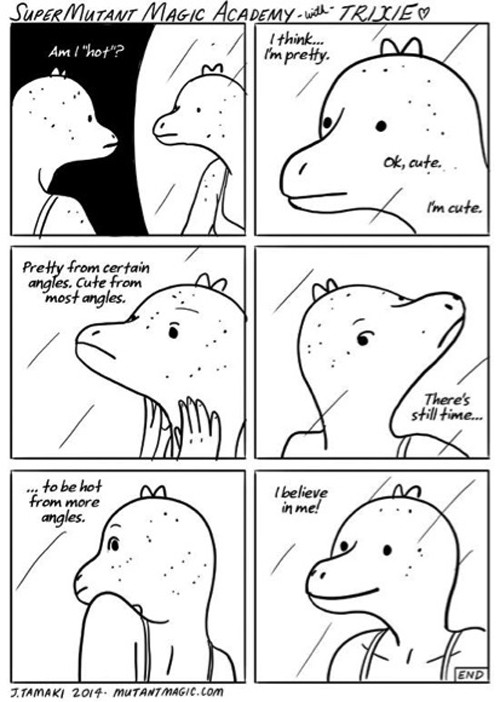
Beauty standards are a recurring theme in your work, from your Have a Sexy Little Halloween, to many SMMA strips. The interactions often center around girls attacking other girls’ choices. In one strip, Wendy shows Marsha the prom dress she’s trying out at a store, and Marsha says, “It’s okay…I guess like your regular clothes better…It’s like you’re trying to look ‘pretty’ or whatever.” Wendy, horrified, says, “That’s EXACTLY how I’m trying to look!” What is it that draws you to write about fashion culture, and how women can cut down other women?
Fashion is both wonderful and terrible, I think. I went to public school and I remember thinking about how I would have LOVED to be forced to wear a uniform. I have since learned from friends that actually wore uniforms that teenagers will always find ways to differentiate themselves. Anyway, I saw clothes as just one more way to create hierarchy, power and currency. Sometimes I still think that way.
That said, obviously fashion is glorious and cool and fun and, often an act of empowerment. I guess I just always identified more with the designer who, after the crazy runway show, pops their head out and they’re wearing jeans and a t-shirt.
As a storytelling device, I think school uniforms are great because they create a weird level playing-field. Like, it strips off some “clues”.
As for women cutting down other women: I am a feminist and believe that and my femaleness colors every thought, experience, interaction. I’m interested in exploring all the elements of that, good/bad/ugly.
I can’t imagine that you think of SMMA as a YA comic, but I’m sure teens are reading it. For young people reading the strip, is there anything in particular that you’d like for them to take away from it?
I would love for teens to read it! I would have wanted to read something like it when I was a teen. I guess I never try to impart anything specific, though. When I was a kid, especially a mixed-race kid in a very white neighbourhood, all I was ever looking for was to see myself reflected (physically and psychologically). I hope it’s an empathetic book.
Annie Mok makes comics solo and collaboratively, sings in See-Through Girls, and contributes to Rookie Magazine. She tweets @HeyAnnieMok.
Photo of Jillian Tamaki by Reynard Li.
Author photo by Thom Carroll c/o PhillyVoice.com